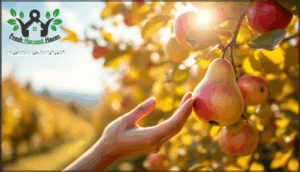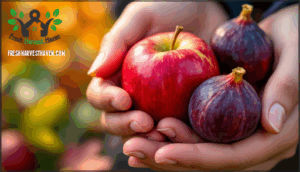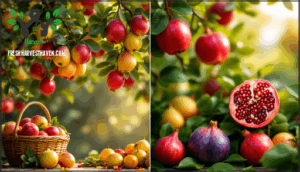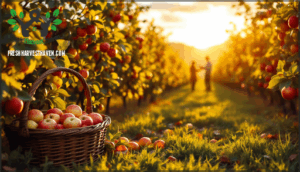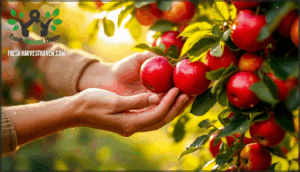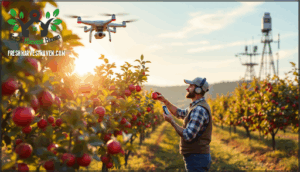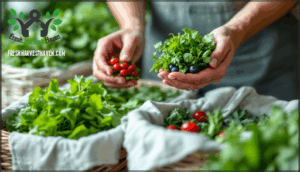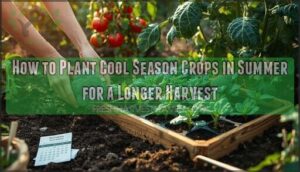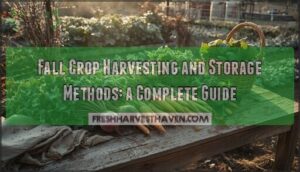This site is supported by our readers. We may earn a commission, at no cost to you, if you purchase through links.
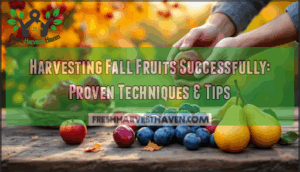
Whether you’re working with apples that need a gentle twist or delicate figs that tear at the slightest tug, mastering these proven methods means you’ll bring in fruit at peak flavor and keep more of your hard-earned harvest intact from tree to table.
Table Of Contents
Key Takeaways
- Timing your harvest to catch fruit at peak ripeness—recognizing visual cues, stem release, and texture changes—makes the difference between exceptional flavor and disappointing quality.
- Different fruits require distinct handling techniques, from the gentle twist-and-lift for apples and pears to the soft touch needed for delicate figs, while understanding climacteric versus non-climacteric fruits determines whether you can ripen them after picking.
- Modern precision tools like drones and ripeness monitoring systems can cut labor waste by 30% and boost yields even in small orchards, proving technology pays for itself within two seasons.
- Post-harvest care—including immediate cooling, proper humidity control, and weekly spoilage checks—extends shelf life significantly and preserves the flavor you worked months to develop.
What is Harvesting and Why It Matters
Harvesting isn’t just about picking fruit—it’s the moment when all your hard work pays off, and timing makes all the difference. Understanding what harvesting means and why it matters will help you get the best quality and yield from your orchard.
Let’s break down the basics before you head out with your basket.
Definition and History of Harvest
Harvesting might sound like something your grandparents did with a hand sickle at dawn, but this ancient practice—dating back roughly 10,000 years to when humans first figured out they could grow their own food—remains the heartbeat of agriculture today.
Fundamentally, the definition of harvest is simple: gathering mature crops from the fields. Yet this seasonal ritual carries profound importance, marking the moment when months of patient work finally pay off and your autumnal harvest transforms from growing plants into food on the table.
Harvesting is the culmination of months of careful work, transforming growing plants into food and making every season of effort worthwhile
Harvest’s Role in Agriculture and Food Supply
Without a successful harvest, the entire agricultural cycle—from planting seeds to pruning branches—would be nothing more than wasted effort, which is why this final step literally feeds the world.
Each fruit bounty you bring in strengthens global food security, bolsters the agricultural labor force, and keeps the supply chain resilient during lean months.
Sustainable harvesting practices guarantee your fruit harvest—whether apples, pears, or pomegranates—maintains high fruit quality while backing the economic crop impact communities depend on throughout the fruit ripening process.
Key Terms: Crop Yield, Season, and Maturity
To make sense of your harvest results and plan for next year, you’ll need to get comfortable with three terms that every orchardist uses: crop yield, season, and maturity. Yield definition is simple—it’s the total amount of fruit you gather. Seasonality impact determines when apples or figs ripen, while maturity stages tell you exactly when each fruit’s reached best yield.
Understanding the fruit ripening process and fruit maturity helps you nail your harvest timing for the best fruit harvest possible.
Factors That Impact Fall Fruit Harvesting
Getting your fall fruit harvest right isn’t just about plucking fruit when it looks ready. A handful of behind-the-scenes factors quietly control when your apples, pears, and pomegranates hit their peak.
Let’s walk through what really drives the timing and quality of your harvest.
Weather Conditions and Timing
You can’t control the weather, but you can learn to work with it—and that’s half the battle when it comes to selecting your fall fruits at the right moment. Frost impact can damage ripe fruit overnight, while rainfall effects may cause splitting in apples and pears.
Check weather data regularly—best forecasts help you nail your harvest timing. Sunlight exposure and temperature fluctuations influence ripening speed, so plan your fruit harvest around these patterns for best harvest time.
Soil Fertility and Plant Variety
Healthy soil feeds your fruit trees from the ground up, and nutrient optimization matters more than you might think. Soil composition affects yield—nitrogen-deficient tissue can drop production by double digits. Apple tree and pear trees respond best when organic matter boosts cation exchange capacity.
Variety selection is equally important: genetic diversity means some persimmon types weigh 62 grams while others hit 315 grams.
Smart orchard management pairs soil health with the right fruit varieties for consistent harvests. Key soil temperatures are significant, as temperatures above 86°F can be deleterious to roots.
Day Length, Climate, and Ripening
As autumn days grow shorter, fruit trees read the light like a calendar, triggering chemical signals that flip the switch from growth to sugar storage. Photoperiod effects combine with temperature impact to control ripening stages—your apple might need cool nights to develop proper fruit texture.
Microclimates create regional variations, so your harvesting season might start two weeks earlier than your neighbor’s, even for the same fall fruit harvest variety.
Identifying Ripeness in Fall Fruits
Knowing when your fall fruits are truly ready makes all the difference between a perfect harvest and picking too soon. You’ll need to look for specific signs that tell you each type of fruit has reached its peak.
Here’s what to watch for so you can time your harvest just right.
Visual and Tactile Signs of Ripeness
Picking fruit at the perfect moment isn’t guesswork—your eyes and hands can tell you more than any calendar ever will. Look for color changes in apples and pomegranates—deep reds or yellows signal readiness. Gently squeeze to check fruit texture; ripe figs soften slightly, while firm apples yield just a bit. Check the stem condition—it should separate easily with a gentle twist.
Don’t forget the aroma check; ripening fruit releases a sweet fragrance that tells you it’s time for fruit harvest.
Climacteric Vs. Non-Climacteric Fruits
Understanding the difference between climacteric and nonclimacteric fruits changes everything about harvest timing and storage protocols. Climacteric fruits like apples and pears keep ripening after you pick them, thanks to ethylene production that triggers softening and sweetening. Non-climacteric fruits such as pomegranates and figs? They stop improving once they leave the tree.
Here’s what this means for your orchard:
- Climacteric fruits offer flexibility—harvest early and let them ripen during storage or transport
- Non-climacteric fruits demand precision—pick at peak ripeness since flavor won’t improve later
- Storage strategies differ dramatically—keep ethylene producers separate to prevent premature ripening
This distinction has real economic impact. Climacteric fruits give you wiggle room with shipping schedules, while ripening fruit that’s non-climacteric requires swift action from tree to table. Knowing your fruit’s ripening mechanisms helps you time everything right and improve quality. To manage this, climacteric fruits benefit from controlled atmosphere facilities.
Best Time of Day for Harvesting
The clock ticks differently for fruit than it does for us, and savvy orchardists work with that rhythm rather than against it. Morning dew evaporates by mid-morning, creating an ideal picking time when fruit temperature stays cool and sugars reach peak levels. Reduced stress during fall fruit harvest preserves quality.
| Time of Day | Why It Works |
|---|---|
| Early morning (after dew dries) | Fruit temperature lowest, firmest texture |
| Late afternoon | Avoid—sun exposure increases bruising risk |
| Midday heat | Never ideal for fruit harvest |
| Overcast days | Extended harvest timing window possible |
Proven Techniques for Harvesting Fall Fruits
Getting the fruit off the tree is only half the battle—how you pick matters just as much as when you pick. Each fall fruit has its own quirks, and knowing the right approach keeps your harvest in top shape.
Let’s walk through the best methods for your orchard favorites.
Methods for Apples, Pears, Figs, and Pomegranates
Each fall fruit has its own personality when it comes to picking—apples and pears need a gentle twist, figs require a soft touch before they tear, and pomegranates practically tell you they’re ready when their skin starts to crack. Here’s what works best for each:
- Apples: Cup the fruit in your palm and lift with a slight twist—if it’s ripe, it’ll release easily without tugging
- Pears: Pick them firm since they ripen best off the tree; same twist-and-lift motion as apples
- Figs: Gently squeeze near the stem—ripe figs feel soft and may show slight neck droop
- Pomegranates: Look for natural skin cracks and a squared shape; they should feel heavy for their size
- Varietal differences: Early-season apples soften faster than late varieties, so adjust your touch accordingly
Harvesting apples and pomegranates when they’re truly ready makes all the difference in flavor.
Tools for Efficient and Safe Picking
Having the right tools in your hands can turn a four-hour picking session into a two-hour one—and save your back and your fruit in the process.
For harvesting apples and pears at height, use sturdy orchard ladders with wide bases—ladder safety matters when you’re reaching overhead. Picking bags with padded bottoms protect your fall fruit harvest better than buckets. Long-handled fruit harvesters with cushioned baskets work great for high branches during pear harvesting, while sharp pruning shears help with stubborn pomegranates.
Don’t skip gloves usage either—they give you better grip and protect against rough bark when you’re using proper fruit picking techniques.
Preventing Bruising and Crop Damage
One bruised apple mightn’t seem like much, but when you’re dealing with bushels of fruit, those soft spots add up to real losses—both in your wallet and your winter fruit supply.
Careful treatment starts with proper tools and container selection—shallow crates beat deep buckets every time for fall fruit harvest. Layer your fruit harvest carefully, never toss or drop, and transport methods matter: drive slowly on bumpy orchard paths.
Preventing bruising during harvest protects storage impact down the line.
Maximizing Yield With Modern Technology
You don’t need a massive operation to benefit from modern harvesting tools. Even small orchards can use technology to improve their harvest timing and boost their yields.
Let’s look at how drones, precision tools, and smart monitoring can make your fall fruit harvest more productive.
Using Drones and Precision Tools
With technology and automation reshaping precision agriculture, you can now work smarter instead of harder. Drones with real-time ripeness monitoring scan your orchard in minutes, spotting fruit that’s ready while cutting labor by 30%. Here’s what modern precision tools bring to your harvest:
- Drone fruit counting delivers 99.91% accuracy for yield mapping and planning
- Precision thinning agents applied by air reduce hand work and chemical waste
- Automated surveys assess ripeness across hundreds of acres fast
- Labor efficiency jumps when drones guide your crew to problem zones
- Waste reduction improves as you pick fruit at peak quality windows
Monitoring and Optimizing Harvest Timing
Once your precision tools pinpoint which rows need attention, smart timing ensures you pick every apple and pear at its flavor peak without letting a single day slip by. Predictive models track ripeness indicators—sugar content, firmness, color—and alert you when fruit maturity hits prime harvest time. That means you can schedule crews efficiently and allocate resources where the ripening process demands them most.
| Timing Strategy | Impact on Harvest |
|---|---|
| Ripeness monitoring systems | Real-time alerts prevent overripe losses |
| Predictive models | Forecast peak windows 3–7 days ahead |
| Optimized scheduling | Match labor availability to fruit readiness |
| Resource allocation tools | Direct equipment and workers to priority zones |
| Labor management software | Reduce idle time, boost crew productivity |
Case Study: Technology in Small Orchards
A small apple grower in Oregon proved you don’t need hundreds of acres to make precision harvesting pay off. With one drone and a smartphone app for data collection, she tracked harvest timing across her five-acre orchard.
Orchard automation cut labor waste by 30 percent, while tech adoption boosted yield improvement through better apples picked at peak ripeness.
Her cost analysis showed technology paid for itself in two seasons.
Post-Harvest Handling and Storage Tips
You’ve done the hard work of picking your fruit at just the right moment, but your job isn’t finished yet. What happens in the hours and days after harvest can make or break the quality of your apples, pears, figs, and pomegranates.
Let’s walk through the essential steps to keep your fall fruits fresh, flavorful, and free from spoilage.
Cooling and Storing Fall Fruits
Getting your freshly picked fruit off the tree and into proper storage isn’t just good practice—it’s the difference between enjoying crisp apples in December and tossing mushy ones by Halloween.
Cool apples, pears, and pomegranates right after harvest to lock in freshness. Store them at ideal temperatures with humidity control to prevent decay.
Keep figs separate—they produce ethylene that speeds ripening in other fruit.
Extending Shelf Life and Preserving Flavor
Storing your harvest right matters, but you can take it further. Modified atmosphere packaging slashes spoilage by half in apples and pomegranates by controlling gas levels around the fruit. Edible coatings extend shelf life up to five times while keeping flavor intact.
Freezing preserves taste and nutrients for a year, while fermentation benefits include extending storage and boosting probiotics.
Keep storage environment humidity below 70% and temperatures cool—heat above 20°C destroys up to 40% of those delicious flavor compounds you worked so hard to grow.
Checking for Spoilage and Quality Maintenance
Even perfect storage won’t save your harvest if you miss the early warning signs of rot creeping through your bins. Check apples and figs weekly for soft spots, mold, or off smells—your first defense in decay prevention.
Here’s what to watch for:
- Soft or mushy spots that indicate internal spoilage before visible mold appears
- Color changes showing overripeness or fungal growth starting beneath the skin
- Moisture buildup in storage containers creating ideal conditions for rot identification
- Wrinkled skin signaling dehydration and declining quality standards
Proper care techniques and storage environment maintenance keep your harvest fresh longer.
Frequently Asked Questions (FAQs)
How often should you check stored fall fruits for spoilage?
You’ll want to check your stored apples, figs, and other fall fruit harvest every few days. Spoilage indicators like soft spots or mold spread quickly, so regular inspections catch problems early and protect the rest of your stash.
Can you harvest underripe fruits and ripen them indoors?
Yes, some fall fruits like apples and pears produce ethylene and can ripen indoors after picking. However, figs and pomegranates won’t improve much off the tree—they need to reach ripeness before harvest for best flavor and sweetness.
How do you prune trees to improve next years harvest?
Pruning your backyard orchard is like giving your trees a strategic haircut—they’ll thank you with bigger, better fruit.
Remove dead or crossing branches in late winter, thin dense canopies to boost sunlight exposure, and cut back last year’s growth on apples and peaches to encourage strong fruiting wood while preventing disease.
Conclusion
You’ve learned the signs, sharpened your timing, and chosen your tools—now you’re ready to walk into your orchard with confidence instead of guesswork. Harvesting fall fruits successfully isn’t about luck or instinct alone; it’s about recognizing that narrow window when sugar peaks, stems release cleanly, and flavor locks in.
Each fruit you pick at the right moment rewards you with taste that no store shelf can match. Treat them gently, store them smartly, and you’ll enjoy the fruits of your patience long after the leaves have fallen.
- https://docs.google.com/forms/d/1GAQr3Kn1cURCVHUA82hAga1Wv8DCH0IuqDLRUrOpN7M/viewform?ts=63f4f653&entry.1515682415=https://www.merriam-webster.com/dictionary%2Fharvest
- https://premium.britannica.com/mw-unabridged/?utm_source=mw&utm_medium=inline-def&utm_campaign=evergreen
- https://www.housebeautiful.com/uk/garden/a2375/harvest-pick-store-fruit/
- https://fruit.webhosting.cals.wisc.edu/wp-content/uploads/sites/36/2011/05/Correlations-of-Fertility-with-Yield.pdf
- https://fruit.wisc.edu/2020/10/15/fall-nutrient-application/

